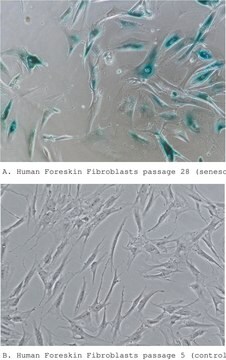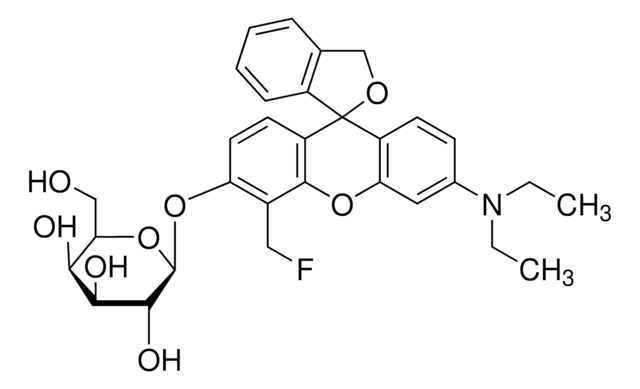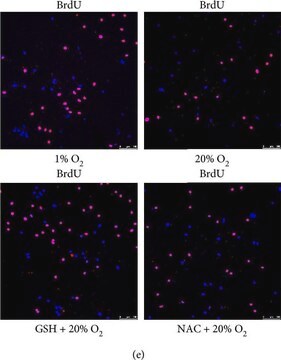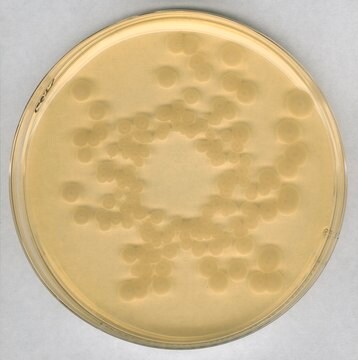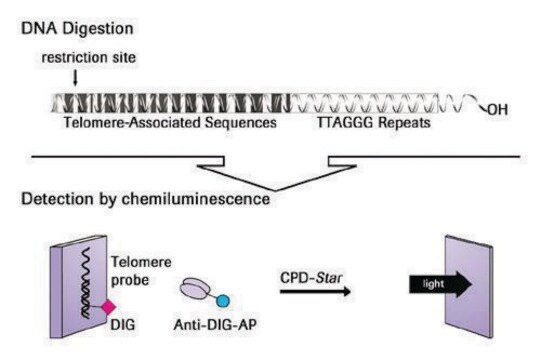KAA002
Cellular Senescence Assay
Cellular Senescence Assay Kits provide all the reagents required to efficiently detect SA-β-gal activity at pH 6.0 in cultured cells & tissue sections.
Synonim(y):
Senescence Detection Kit
About This Item
Polecane produkty
Poziom jakości
producent / nazwa handlowa
Chemicon®
metody
cell based assay: suitable
metoda wykrywania
colorimetric
Warunki transportu
wet ice
Opis ogólny
It is generally believed that cellular senescence reflects some of the changes that occur during the aging of organisms, and senescent cells have been detected in vivo at sites of age-related pathology, such as benign hyperplastic prostate [4] and atherosclerotic lesions [5]. Recent studies have also provided convincing demonstrations of cellular senescence occurring in vivo in response to internally- and externally-induced stress signals [6,7]. In all of these studies, senescence was characterized by the appearance of senescence-associated β-galactosidase (SA-β-gal) activity, in common with the senescent phenotype in vitro.
Cellular senescence has become an increasingly important target in the development of novel therapeutics. Emerging data implicates senescence bypass in the development of cancer and suggests that senescence may represent a tumor suppressor mechanism. The demonstration that tumor cells can be induced to undergo replicative senescence following the introduction of negative cell-cycle regulators, anti-telomerase peptides, or drug treatment suggests that induction of senescence can be exploited as a basis for cancer therapy [8,9].
For Research Use Only; Not for use in diagnostic procedures
Test Principle:
As outlined above, a classic characteristic of the senescent phenotype is the induction of senescence-associated β-galactosidase (SA-β-gal) activity. SA-β-gal is present only in senescent cells, not in presenescent, quiescent, or proliferating cells. Chemicon′s Cellular Senescence Assay Kit provides all the reagents required to efficiently detect SA-β-gal activity at pH 6.0 in cultured cells and tissue sections. In this assay, SA-β-gal catalyzes the hydrolysis of X-gal, which results in the accumulation of a distinctive blue color in senescent cells. Each kit provides sufficient quantities of reagents to perform at least 50 assays in 35 mm wells.
Zastosowanie
Komponenty
10X Staining Solution A: (Part No. 2004756) One 15 mL bottle
10X Staining Solution B: (Part No. 2004754) One 15 mL bottle
X-gal Solution: (Part No. 2004752) Two 1.5 mL vials
Przechowywanie i stabilność
Precautions:
Please refer to the Material Safety Data Sheet at www.chemicon.com for any necessary precautions.
Informacje prawne
Oświadczenie o zrzeczeniu się odpowiedzialności
Hasło ostrzegawcze
Danger
Zwroty wskazujące rodzaj zagrożenia
Zwroty wskazujące środki ostrożności
Klasyfikacja zagrożeń
Acute Tox. 4 Dermal - Acute Tox. 4 Inhalation - Acute Tox. 4 Oral - Aquatic Acute 1 - Aquatic Chronic 2 - Eye Dam. 1 - Flam. Liq. 3 - Repr. 1B - Resp. Sens. 1 - Skin Corr. 1B - Skin Sens. 1 - STOT SE 3
Organy docelowe
Respiratory system
Zagrożenia dodatkowe
Kod klasy składowania
3 - Flammable liquids
Temperatura zapłonu (°F)
135.5 °F
Temperatura zapłonu (°C)
57.5 °C
Certyfikaty analizy (CoA)
Poszukaj Certyfikaty analizy (CoA), wpisując numer partii/serii produktów. Numery serii i partii można znaleźć na etykiecie produktu po słowach „seria” lub „partia”.
Masz już ten produkt?
Dokumenty związane z niedawno zakupionymi produktami zostały zamieszczone w Bibliotece dokumentów.
Klienci oglądali również te produkty
Nasz zespół naukowców ma doświadczenie we wszystkich obszarach badań, w tym w naukach przyrodniczych, materiałoznawstwie, syntezie chemicznej, chromatografii, analityce i wielu innych dziedzinach.
Skontaktuj się z zespołem ds. pomocy technicznej